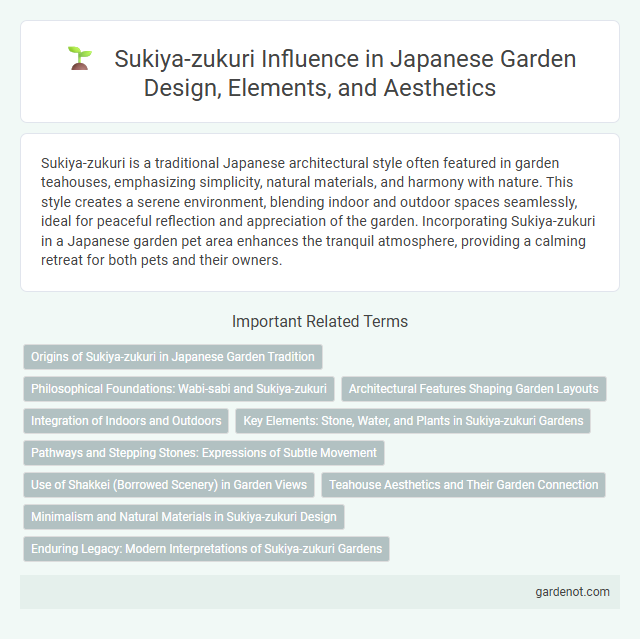Sukiya-zukuri is a traditional Japanese architectural style often featured in garden teahouses, emphasizing simplicity, natural materials, and harmony with nature. This style creates a serene environment, blending indoor and outdoor spaces seamlessly, ideal for peaceful reflection and appreciation of the garden. Incorporating Sukiya-zukuri in a Japanese garden pet area enhances the tranquil atmosphere, providing a calming retreat for both pets and their owners.
Origins of Sukiya-zukuri in Japanese Garden Tradition
Sukiya-zukuri architecture originated in the 16th century as an aesthetic response to the tea ceremony culture, emphasizing simplicity, natural materials, and refined elegance within Japanese garden settings. This style evolved from traditional samurai residences and teahouses, incorporating elements like tatami mats and shoji screens to harmonize indoor and outdoor spaces. Its design principles promote a seamless blend with the surrounding garden landscape, fostering tranquility and contemplation.
Philosophical Foundations: Wabi-sabi and Sukiya-zukuri
Sukiya-zukuri architecture embodies the Japanese aesthetic philosophy of wabi-sabi, emphasizing simplicity, imperfection, and natural beauty. The design integrates asymmetry, rustic materials, and subtle textures to create an atmosphere of tranquility and refined elegance. Rooted in Zen Buddhism, wabi-sabi inspires Sukiya-zukuri to celebrate impermanence and the authenticity of handcrafted details within Japanese gardens.
Architectural Features Shaping Garden Layouts
Sukiya-zukuri architecture emphasizes natural materials, asymmetrical designs, and delicate wooden structures that harmonize with the surrounding garden. Its features, such as sliding shoji screens and engawa (verandas), create fluid transitions between indoor and outdoor spaces, influencing garden layouts to prioritize intimacy and seasonal views. This architectural style shapes gardens by integrating teahouse aesthetics with carefully arranged plants, stones, and water elements, enhancing the overall sense of tranquility and balance.
Integration of Indoors and Outdoors
Sukiya-zukuri architecture seamlessly integrates indoor spaces with the natural landscape through large sliding doors and open verandas, creating a harmonious flow between the house and garden. This design philosophy emphasizes the use of natural materials like wood and paper to blend interior aesthetics with outdoor elements such as stone pathways and lush greenery. The careful alignment of interior rooms with garden views enhances a serene atmosphere, inviting contemplation and a deep connection with nature.
Key Elements: Stone, Water, and Plants in Sukiya-zukuri Gardens
Sukiya-zukuri gardens emphasize harmony through the strategic placement of stone arrangements symbolizing stability and permanence. Carefully designed water features, such as ponds or flowing streams, create a serene atmosphere reflecting natural tranquility. Plants, including moss, bamboo, and seasonal blossoms, enhance the garden's aesthetic by blending softness and texture, embodying simplicity and refined beauty in Sukiya-zukuri design.
Pathways and Stepping Stones: Expressions of Subtle Movement
Sukiya-zukuri pathways and stepping stones guide visitors through Japanese gardens with deliberate irregularity, embodying the concept of subtle movement and natural flow. These elements reflect wabi-sabi aesthetics by emphasizing asymmetry, texture, and seasonal changes in moss and stone surfaces. Carefully arranged stepping stones invite mindful walking, encouraging pause and contemplation within the tranquil Sukiya garden setting.
Use of Shakkei (Borrowed Scenery) in Garden Views
Sukiya-zukuri architecture masterfully incorporates shakkei, or borrowed scenery, by framing natural elements such as distant mountains, trees, or water features within garden views to create an illusion of expanded space and harmony with the environment. This technique enhances the garden's aesthetic by seamlessly integrating the built environment with the surrounding landscape, fostering a tranquil and contemplative atmosphere. The careful alignment of verandas and windows in sukiya-style teahouses optimizes the borrowed scenery, emphasizing seasonal changes and natural beauty.
Teahouse Aesthetics and Their Garden Connection
Sukiya-zukuri exemplifies refined Japanese teahouse aesthetics characterized by simplicity, natural materials, and asymmetrical design that harmonizes with its surrounding garden. The architecture intentionally incorporates elements such as shoji screens, tatami mats, and tokonoma alcoves, creating serene spaces that reflect wabi-sabi principles and foster mindfulness. Gardens designed adjacent to Sukiya-zukuri structures often feature carefully placed stones, water basins, and moss, establishing an intimate dialogue that enhances the spiritual ambiance and seamless integration between indoor and outdoor environments.
Minimalism and Natural Materials in Sukiya-zukuri Design
Sukiya-zukuri design emphasizes minimalism through its clean lines, uncluttered spaces, and restrained ornamentation, creating a tranquil and contemplative atmosphere in Japanese gardens. The use of natural materials such as cypress wood, bamboo, and paper enhances harmony between indoor and outdoor environments, reflecting the traditional aesthetic of wabi-sabi. This architectural style integrates seamlessly with the garden landscape, promoting simplicity, elegance, and an intimate connection with nature.
Enduring Legacy: Modern Interpretations of Sukiya-zukuri Gardens
Sukiya-zukuri gardens embody a timeless aesthetic rooted in traditional Japanese architecture, emphasizing simplicity, natural materials, and harmony with nature. Modern interpretations preserve these principles by integrating minimalist design, sustainable elements, and contemporary landscaping techniques that enhance tranquility and spiritual reflection. This enduring legacy continues to influence garden design globally, blending classical elegance with innovative environmental sensibilities.
Sukiya-zukuri Infographic

 gardenot.com
gardenot.com